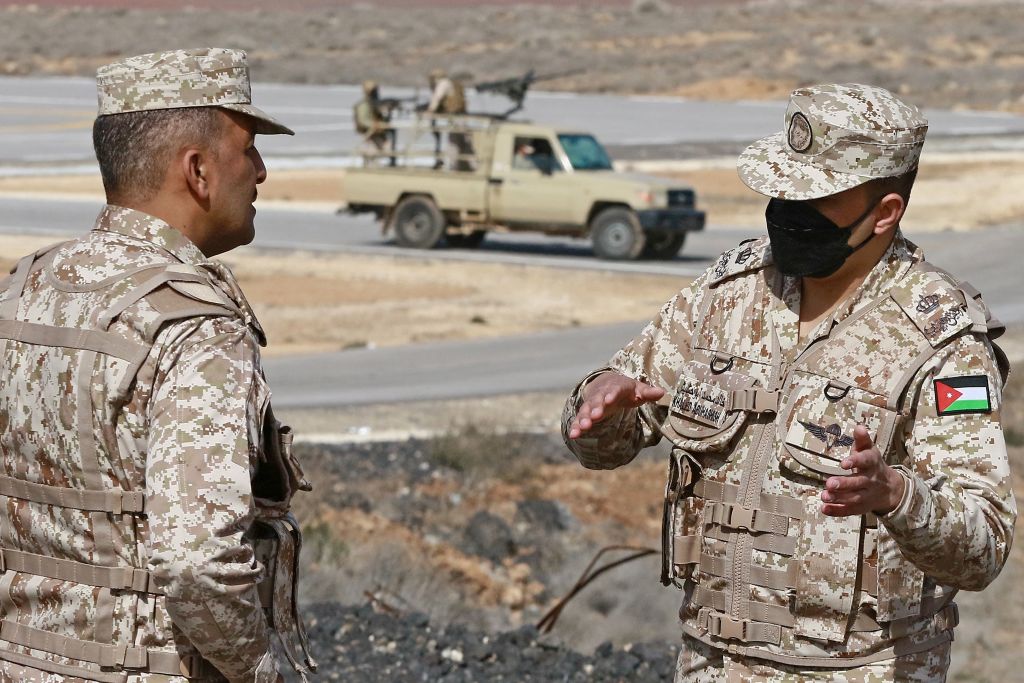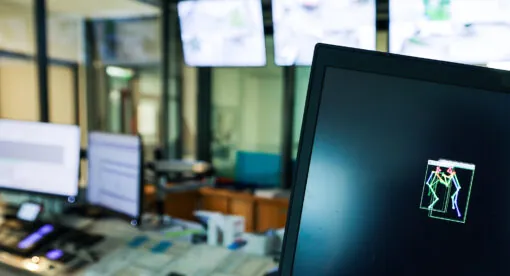Listen to article
Over the past year, Jordan has received criticism for an apparent warming of relations with Syria. A notable border crossing opening in 2021 and dialogues between both heads of state and ministers of defense and foreign affairs reinforced speculation that the two are escalating efforts to normalize bilateral ties, prompting concerns from the United States as it works to isolate the government of Syrian President Bashar al-Assad. But while the two governments are interested in cooperating on trade and border security, an uptick in clashes related to the captagon drug trade and Iran-aligned influence in southern Syria has ensured that Jordan is still a long way from normalization with Syria.
As the captagon trade booms and rising insecurity in southern Syria continues, the U.S.-Jordanian relationship—specifically security cooperation along the Jordanian-Syrian border—will, too, change. Over a decade after the U.S.-Jordanian cooperative efforts in building force capacity and establishing a border surveillance detection and interdiction system along Jordan’s border with Syria, there is an opportunity to strengthen security ties as Amman seeks to stave an overspill of violence, illicit trades, and transnational threats emanating from Syria. As the pace of rapprochement between Damascus and Amman lessens, the U.S. should work to identify a strategy with Jordan to serve as a proactive, supportive partner in promoting border and regional security.
An Unsteady Relationship
One of Jordan’s primary national security interests is the protection of its borders, staving off any overspill of regional violence and instability. Since 2011, Syria has been the principal source of that security risk. The Syrian Arab Army’s violent crackdown and subsequent bloody military operation in southern Syria pushed as many as 1.2 million Syrian refugees into Jordan, where most remain over a decade later with no solution in sight. The growth of the Islamic State group and other extremist elements among Syrian opposition along the Syrian-Jordanian border further heightened Jordan’s military readiness and operational activities to prevent terrorist actors from infiltrating the kingdom.
In 2017, the Syrian military renewed operations in the south to root out Islamic State-affiliated elements in Yarmouk and organized the forced relocation of the remainder of the Southern Front – an alliance of Syrian opposition groups operating principally in Daraa city – via a Russian-, Turkish-, and Iranian-backed de-escalation strategy dubbed the Astana Process. Jordan, an observing member of Astana, had high hopes for the new agreement and began to prepare, alongside the Syrian government, for the reopening of its border crossing for the resumption of trade. The unsteady de-escalation agreement, however, did not fulfill the hopes of the Jordanian government and incentivized it to pursue bilateral engagement with Syria. Jordan hoped that even tacit cooperation could stimulate economic and security progress along their shared border, improve the war-battered economy in its northern region, and create opportunities for transnational energy projects with Egypt to stabilize the ongoing crisis in Lebanon.
Jordan’s geostrategic gains from the de-escalation of conflict in the south were meager compared with the challenges that emerged. First, although reopening the border did renew some level of trade with Syria, it reached only $94 million as of 2020, 15 percent of its prewar trade volume. Instead, Jordan has looked to bolster economic and trade ties with Iraq, Saudi Arabia, Egypt, and the United Arab Emirates to offset low trade volumes with Syria.
Second, the removal of Syrian opposition elements from southern Syria did not bring about a sustainable peace, as a series of sectarian and tribal feuds, interactional contestation, and power struggles among warlords resulted in residual assassinations and violent inaugurations. Third, the deployment of Syrian military forces to the south created ample opportunity for Hezbollah and Iranian-linked militias to develop a presence in pockets along the Syrian-Jordanian border, a concern that King Abdullah has continued to raise with a number of international partners, including Russia and the United States, in a bid to find a way to remove them.
Fourth, the economic disparity in Syria’s embattled south, paired with a need to identify new overland transit routes to destination markets in the Persian Gulf, drove a new black market industry focused on the production, development, and smuggling of captagon, an amphetamine-type substance commonly dubbed the “poor man’s cocaine,” from Syria through Jordan to a growing market in the Arab Gulf. The captagon trade has increased smuggling and related violence across the length of Jordan’s northern border, posing new challenges to Jordan’s advanced border surveillance system there and drawing a significant influx of U.S. cash to develop and maintain an advanced border security program and response force.
Despite high-level engagement between Jordanian officials, including Chief of Defense Yousef Hneity, with Syrian counterparts, the cross-border risk of violence emanating from Syria has steadily increased, and the cost, in terms of blood and treasure, has risen significantly. From 2018 to 2021, the Jordanian Armed Forces routinely prevented the incursion of smugglers – many aligned with the Syrian Fourth Division and its Iran-aligned security partners. While smuggling of illicit goods had persisted along the Jordanian-Syrian border, there was a notable uptick in overland smuggling operations that followed the opening of the Nassib-Jaber border crossing in September 2021, with numerous recorded clashes between Jordanian forces and smugglers.
The violence reached new heights in 2022 following the death of a Jordanian officer, Capt. Muhammad Khudarat, in a skirmish with smugglers along the border. In two separate attacks since then, the Jordanian Armed Forces have responded to border incursions by armed, coordinated smugglers in numbers reaching as high as 200, and have killed as many as 27. Furthermore, evidence that captagon smugglers had adopted advanced tools such as drones and armored vehicles and exploited the Jordanian border surveillance system’s vulnerabilities during challenging weather conditions with impressive manpower, has added further gravitas to Jordan’s border security predicament.
Dancing While Wrestling With the Devil
Khudarat’s death should not be understated in the psyche of Jordan’s defense establishment. Similar to its reaction after the Islamic State group’s brutal murder of Jordanian pilot Muath Kasasbeh in 2015, Jordan has responded to cross-border smuggling with increased lethality, driven by a change in its military’s rules of engagement authorizing personnel to preemptively engage hostile targets encroaching the border with lethal force. Khudarat’s death may yet have larger implications for Jordan’s view of normalization with Syria, particularly as the Jordanian government continues to expose links between the Syrian military, its Iranian-aligned partners such as Hezbollah and Islamic Revolutionary Guard Corps militias, and the captagon trade.
Those potential links, and more specifically the smuggling of captagon through Jordan, reinforce Jordan’s view of the Syrian military as an unreliable partner. That perception is compounded by a potential downsizing of the Russian operational presence in the south, seen in Amman as a bulwark to Iran and cross-border instability – even as the Jordanian military seeks to increase cooperation to reduce the growing smuggling problem. Increasing this concern are recent signs that Hezbollah-aligned militias have sought to build additional captagon manufacturing sites in Suwayda and Daraa, as well as a spike in violence among elements of Syria’s Fourth Division, military intelligence, and Air Force intelligence over control and profits from the drug trade in southern Syria.
It also raises questions about the extent to which Damascus has command and control of forces deployed to the south, or whether the regime gives tacit approval to its forces’ involvement. Several reports and analyses over the past few years have connected captagon production to elements directly and indirectly affiliated with the Assad regime, but in May 2022, the Jordanian government revealed explicit links between Syrian military forces and those killed in cross-border skirmishes, notably breaking the precedent of broad characterizations and applying direct pressure on counterparts in Damascus to stem captagon flows into Jordan.
With Syria, Jordan faces the unique challenges inherent in attempting to maintain a balance between countering national security threats from Syria and improving its strategic lift along its border with the broader regional trend of Arab normalization with Syria. Assad is likely not going anywhere, but the structural implications of his regime are likely to translate into continued security challenges for Jordan, often with either limited support from or in opposition to Syrian forces across the border.
This raises the stakes for Jordan’s security apparatus to understand who is operating across the border to develop an effective mechanism for vetting subunits and border security within the Syrian military. This will be particularly salient to ensure that Jordan can identify potential Iranian- or Hezbollah-linked elements in, near, or close to Syrian forces and leverage evidence of these ties in ongoing security dialogues with Syria while exposing Syrian participation in illicit revenue streams such as captagon.
What the U.S. Can Do
Jordan does not trust Syria, and the Syrian government lacks the means or the will to build that trust. Doing so would require Syria to make systemic changes to rein in the growing role of Iranian militias on Jordan’s border, implement more rigorous vetting of the activities of Syrian forces and Syrian-aligned elements in the south involved in smuggling operations, and improved conditions for bilateral trade. Furthermore, normalization of their relations is not likely until cross-border smuggling, alongside a number of destabilizing factors in southern Syria – rampant poverty, insecurity, unemployment, and more – are addressed.
U.S. policymakers have the opportunity to address the immediate and systemic challenges that Jordan is facing as it seeks stability along its border with Syria. The Biden administration can help Jordan navigate the complexities of its evolving relationship with the Syrian government, particularly in determining the best approach to engagement balancing Jordan’s legitimate security concerns with ensuring Jordan is in line with U.S. policy on engaging with the Assad regime. The departments of state and defense can enhance advisory and material support for Jordan’s surveillance detection and interdiction system as part of U.S. defense assistance under the 2023 memorandum of understanding, currently under negotiation. And Congress, where Jordan enjoys broad support, can work with the White House to ensure its foreign policy priorities for Jordan, including border security assistance, are sufficiently funded through legislation, such as the next National Defense Authorization Act, or approval of the forthcoming U.S.-Jordan memorandum.
While strengthening Jordan’s border security and surveillance system will be a short-term solution to blocking illicit flows and preventing insecurity spillover from southern Syria, the broader picture and principal driver of Jordan’s engagements with Syria – restarting economic trade – depends on stability in the south. The potential reduction of Russian forces in Syria, as a result of the ongoing war in Ukraine, and intensifying influence of Iran-aligned groups in the region may only worsen conditions in southern Syria. Furthermore, Washington and Amman should work closely to encourage an interregional dialogue among affected transit and destination countries over the sharing of intelligence, best practices, and information about the captagon trade.
For this reason, it is important that the U.S. seek to help Jordan identify ways to constructively engage with the Syrian government to meet challenges related to illicit narcotics streams, border clashes, and the shifting security presence in Syria’s south, short of normalization. As Jordan adjusts its strategy to address its concerns about cross-border violence and the rising influence of Iranian-aligned militias along its border with Syria, Washington can play a proactive, supportive role as it seeks greater security and stability in the region.
Caroline Rose is a Senior Analyst and Head of the Strategic Vacuums program in the Human Security unit at New Lines. Her commentary and work on geopolitics and Middle Eastern affairs have been featured in Foreign Policy, The Independent, Alhurra, Limes Magazine, and the Atlantic Council’s MENASource. She tweets at @CarolineRose8.
Jesse Marks is a Nonresident Fellow with the Stimson Center’s China Program where he focuses on peace and conflict studies, humanitarian response, and China-Middle East relations. From 2020-2022, Marks served as an advisor for Middle East Policy in the Office of the Secretary of Defense, Office of the Under Secretary of Defense for Policy in both the Trump and Biden administrations. He holds a MPhil in International Relations and Politics from the University of Cambridge. He tweets at @JesCMarks.
The views expressed in this article are those of the author and not an official policy or position of the New Lines Institute.







